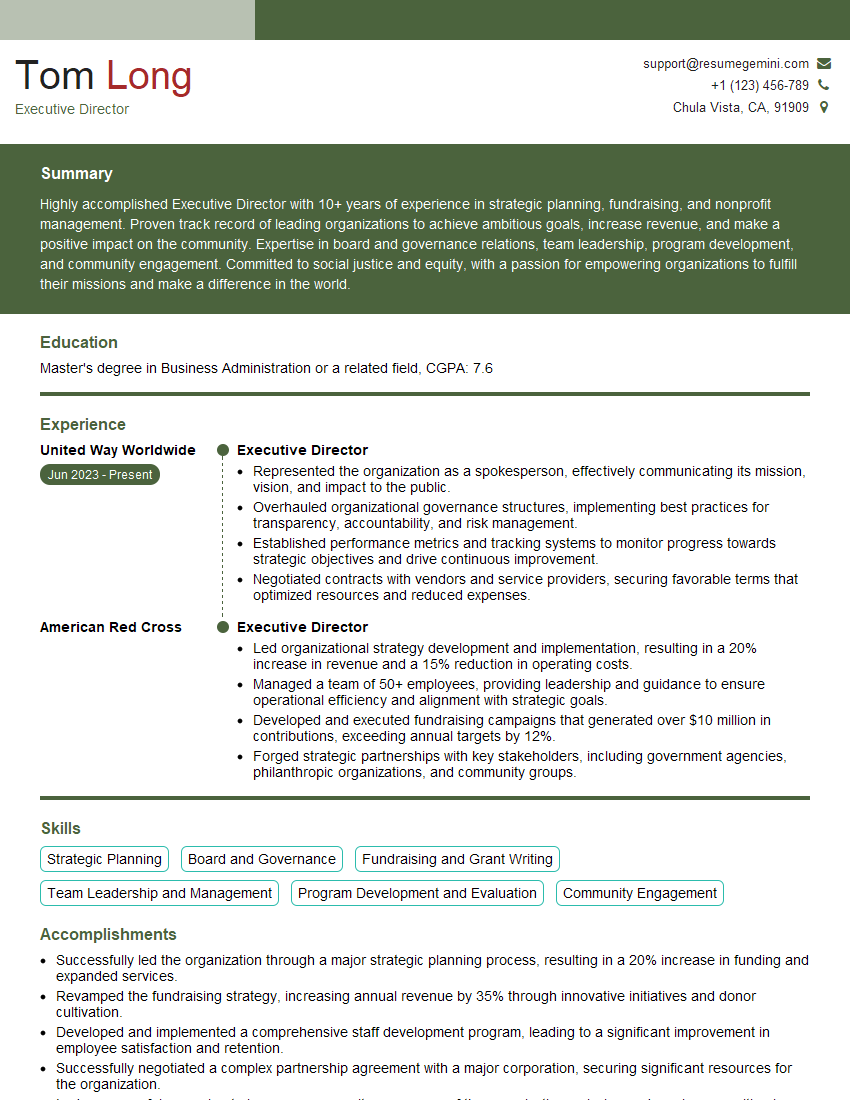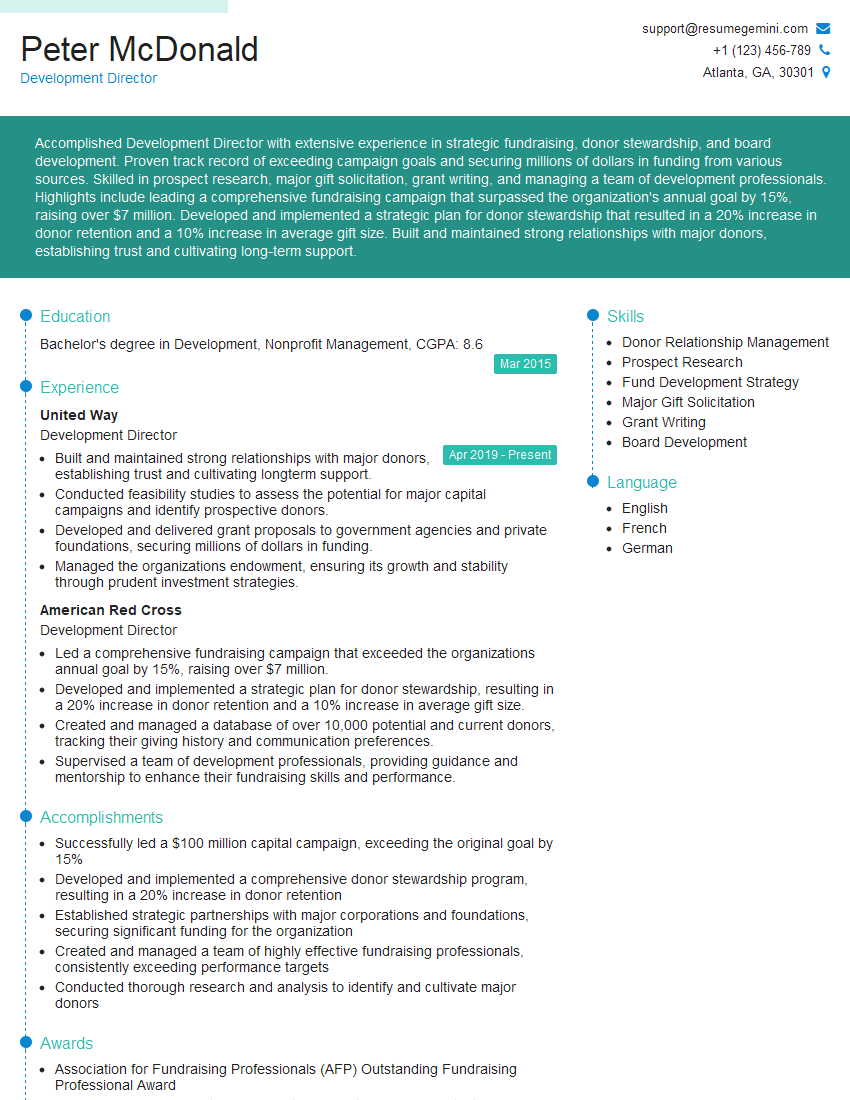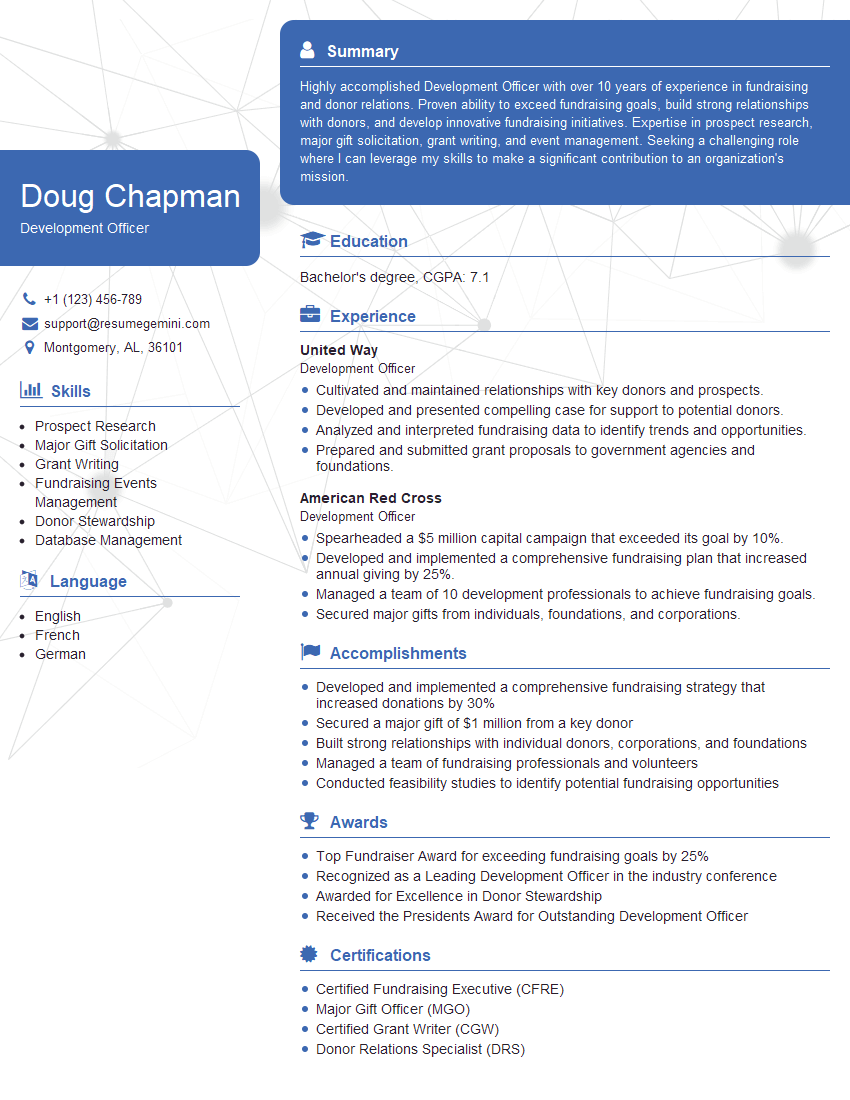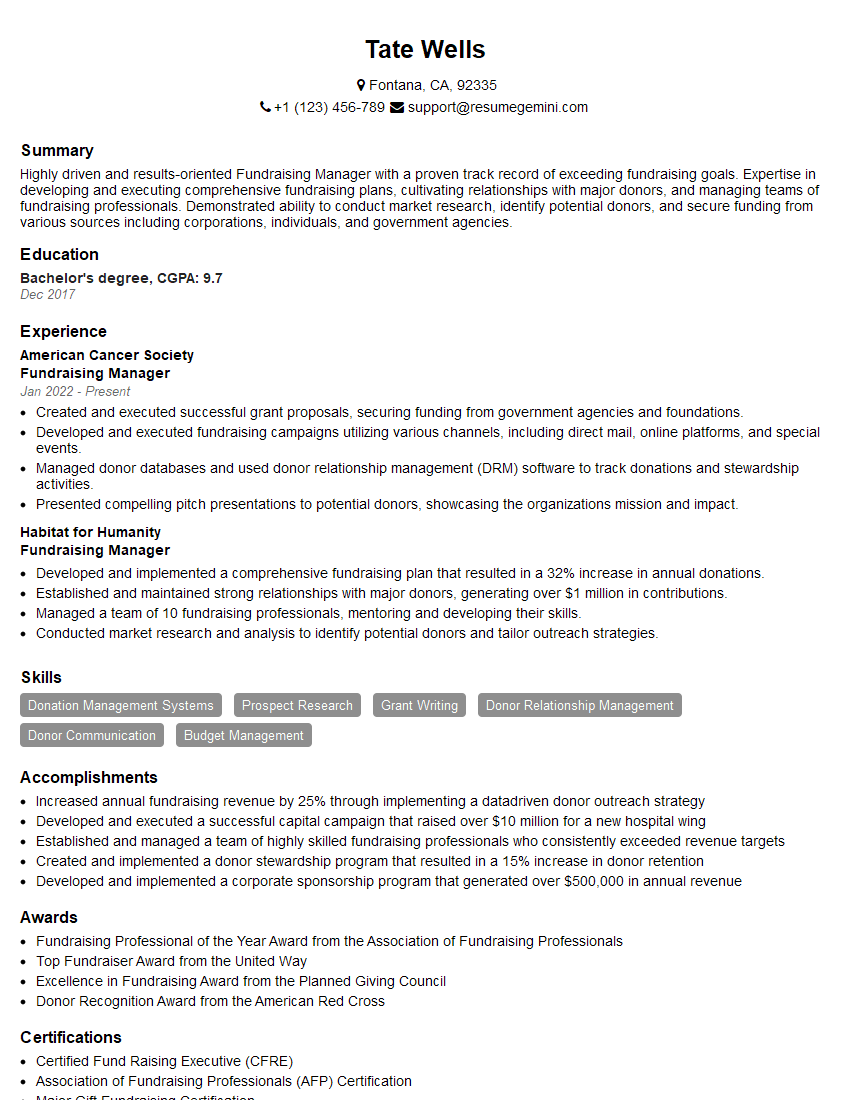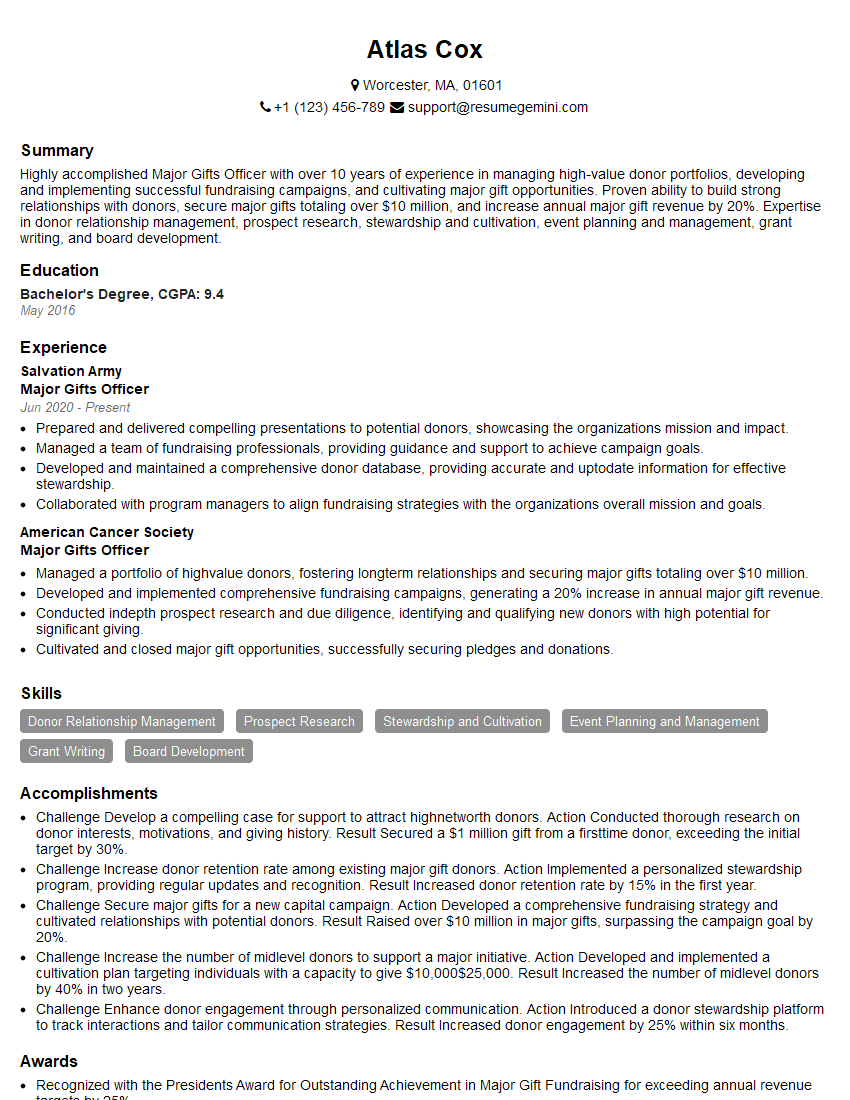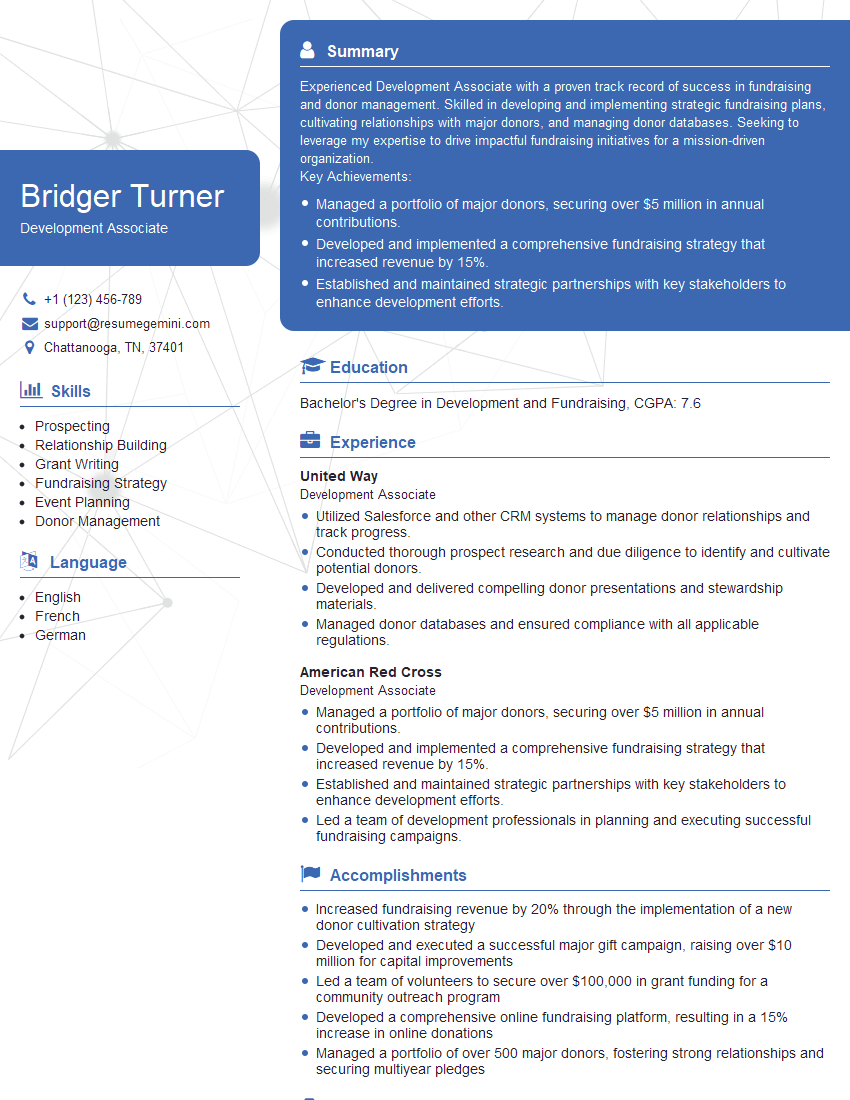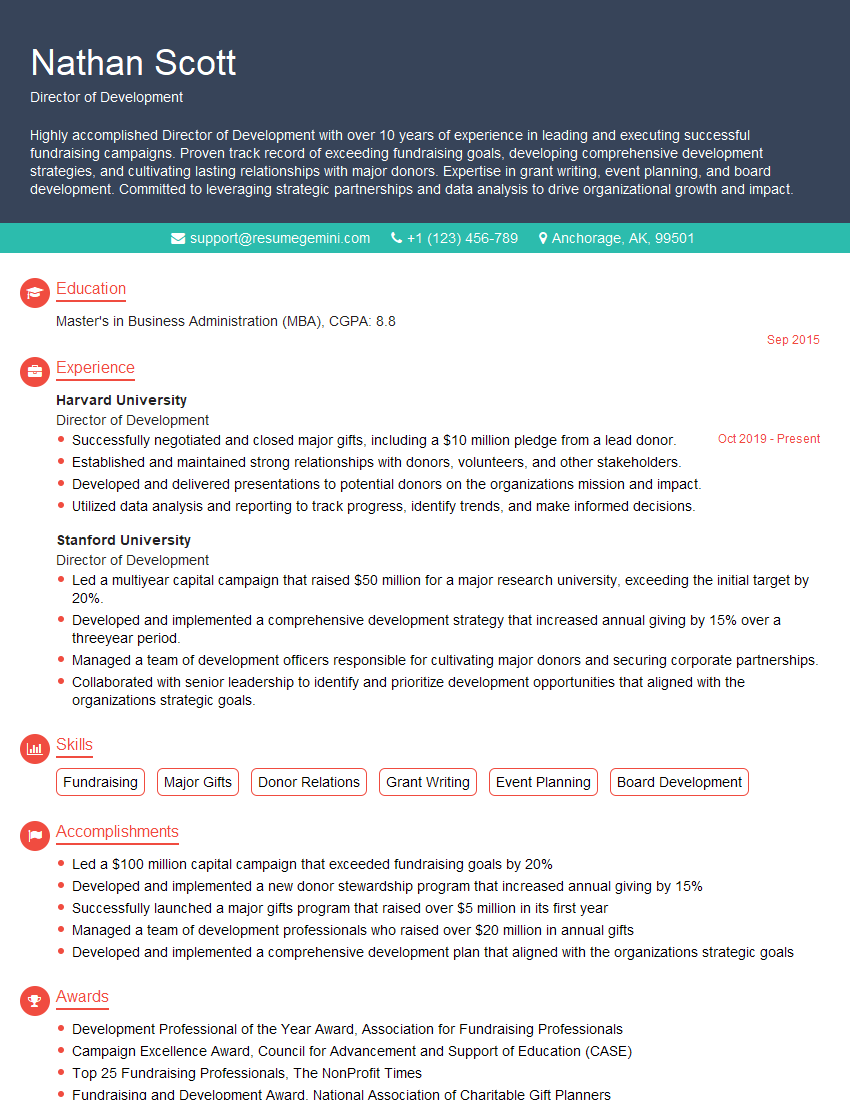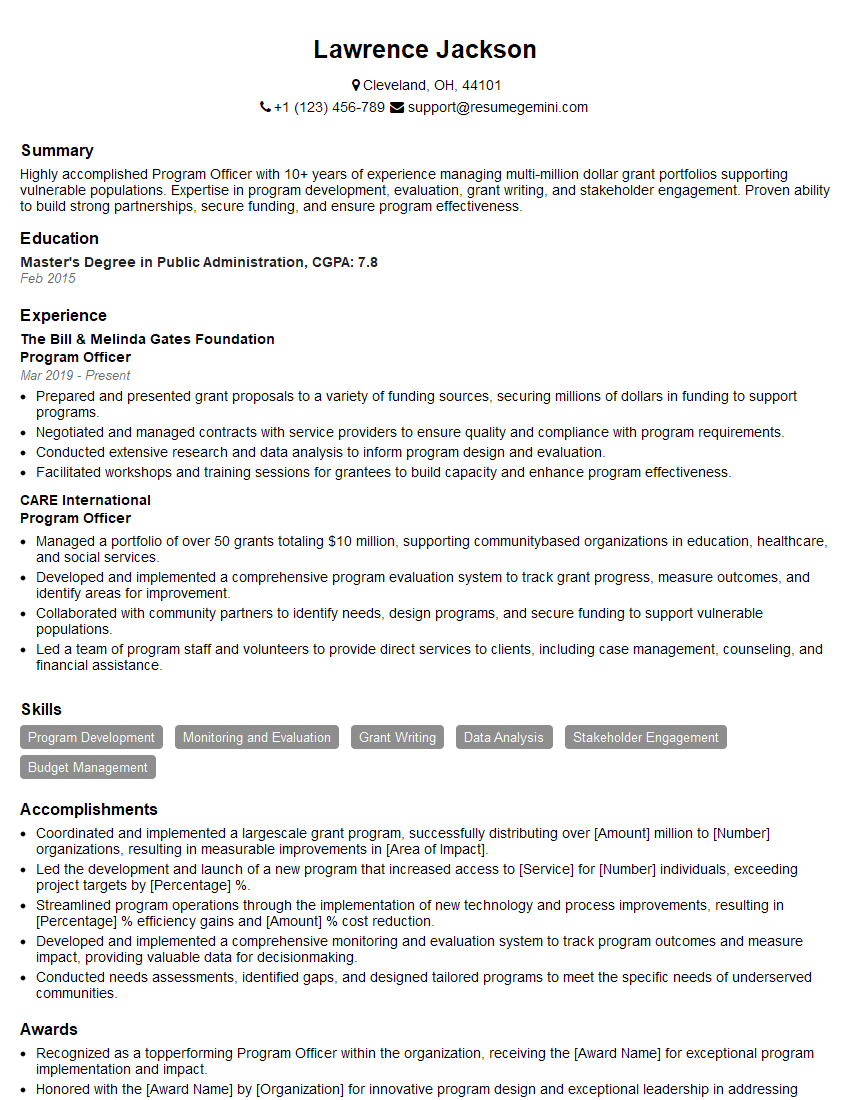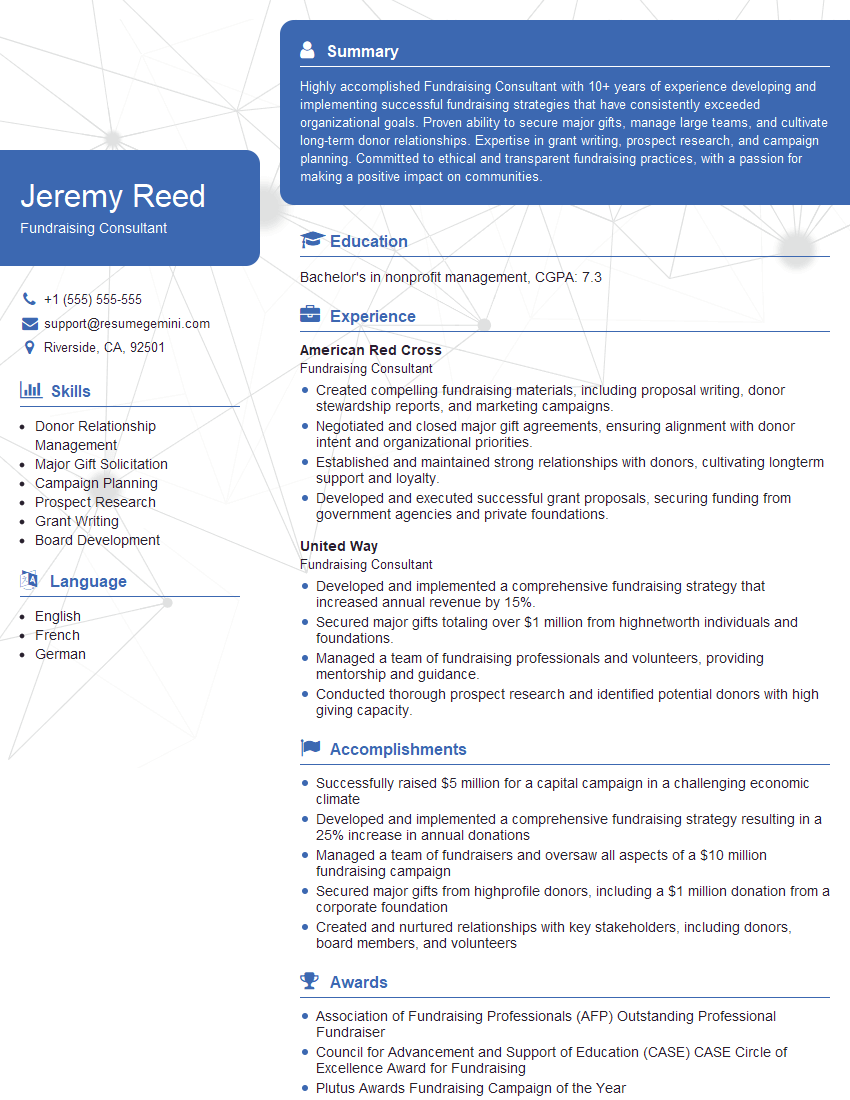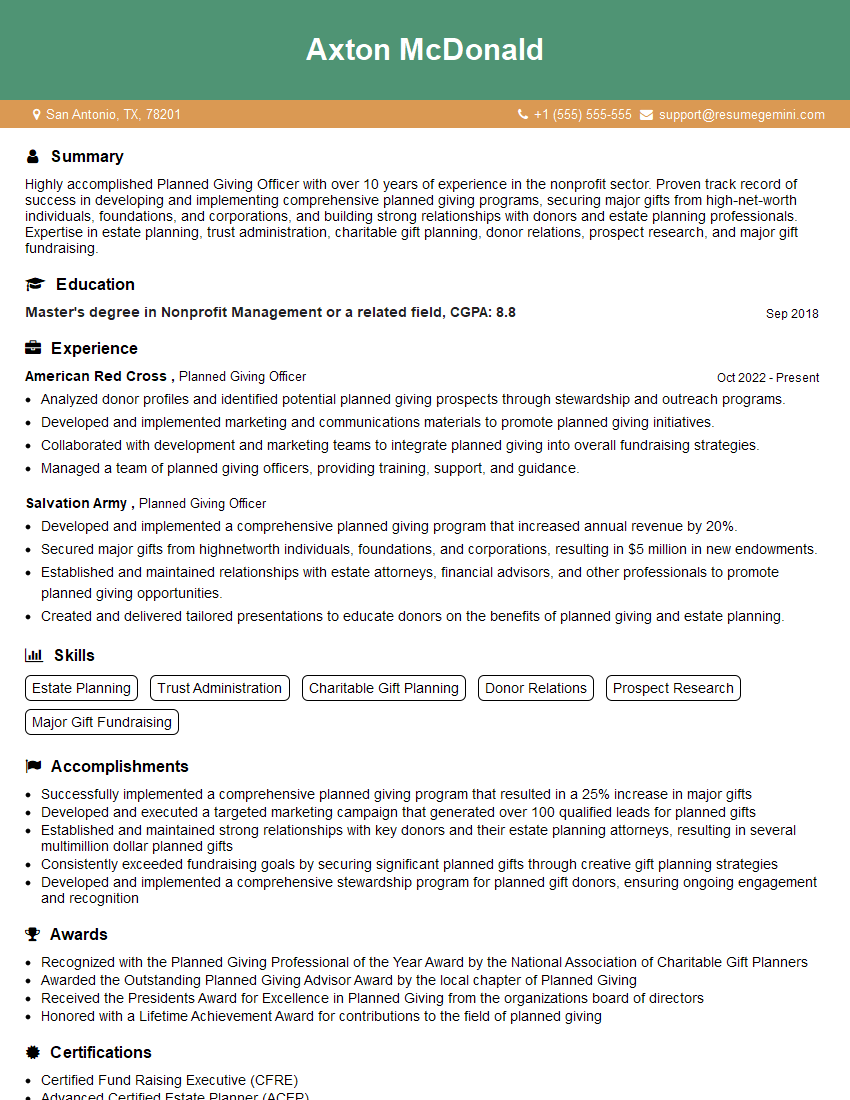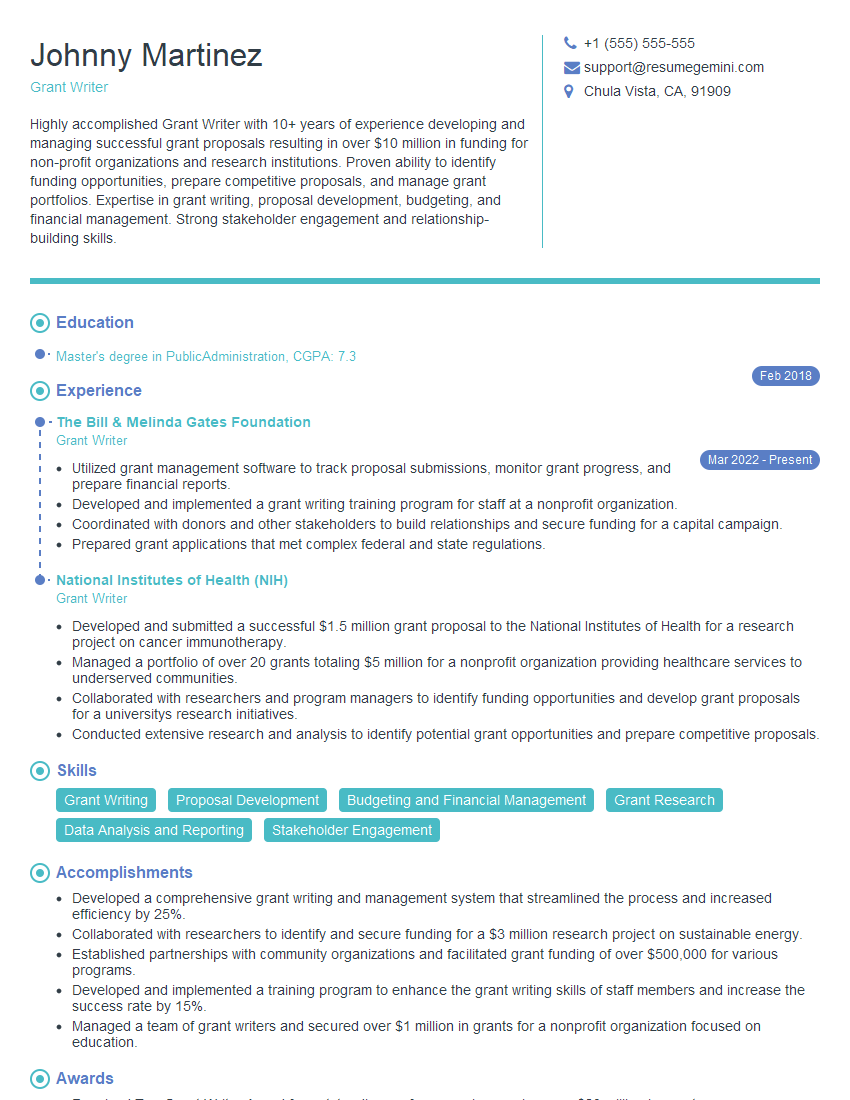Every successful interview starts with knowing what to expect. In this blog, we’ll take you through the top Fund Raising and Development Strategies interview questions, breaking them down with expert tips to help you deliver impactful answers. Step into your next interview fully prepared and ready to succeed.
Questions Asked in Fund Raising and Development Strategies Interview
Q 1. Describe your experience with developing and implementing a comprehensive fundraising plan.
Developing a comprehensive fundraising plan is like creating a roadmap to reach a financial destination. It requires a deep understanding of the organization’s needs, target audience, and available resources. My approach begins with a thorough needs assessment, defining specific, measurable, achievable, relevant, and time-bound (SMART) goals. This involves analyzing the organization’s budget, identifying funding gaps, and projecting future financial needs. Next, I develop diverse fundraising strategies encompassing major gifts, planned giving, grants, corporate sponsorships, individual giving, and special events. Each strategy is meticulously planned with timelines, budgets, and responsible parties clearly outlined. For example, in my previous role at the XYZ Charity, I spearheaded the development of a five-year fundraising plan that successfully increased annual revenue by 40% by diversifying income streams and implementing a robust donor stewardship program.
Implementation involves meticulous tracking of progress against the plan, regular reporting to stakeholders, and making data-driven adjustments as needed. This iterative process ensures the plan remains relevant and effective throughout its lifecycle. For instance, we regularly reviewed our performance against key metrics and adjusted our strategies to focus on the most successful channels. This iterative process is crucial to maximizing results.
Q 2. How do you identify and cultivate major gift prospects?
Identifying and cultivating major gift prospects requires a strategic and relationship-focused approach. It’s not simply about finding wealthy individuals; it’s about finding individuals with a genuine affinity for the organization’s mission. My process starts with research, identifying individuals who have demonstrated a history of philanthropy, particularly within areas aligned with our cause. This involves leveraging databases like GuideStar, wealth screening tools, and networking within the organization’s existing community.
Cultivation is key. It’s about building genuine relationships, understanding their philanthropic interests, and demonstrating the impact of their potential gift. This might involve personalized communications, invitations to exclusive events, site visits, and regular updates on the organization’s work. For example, I successfully cultivated a relationship with a potential donor by sending them a personalized letter highlighting a project that aligned with their passion for environmental conservation, ultimately resulting in a six-figure donation.
Regular engagement and meaningful updates are vital. Transparency and consistent communication build trust and make donors feel valued. This ensures that prospective donors understand the impact of their gift.
Q 3. Explain your approach to managing donor relationships.
Donor relationship management is the cornerstone of successful fundraising. It’s about building and nurturing long-term partnerships based on mutual trust and respect. My approach involves segmenting donors based on their giving history, interests, and relationship level. This allows for personalized communication and engagement strategies.
I utilize a Customer Relationship Management (CRM) system to track interactions, preferences, and giving patterns. This ensures that communications are relevant and timely. For instance, I might send a thank-you note immediately after a gift, follow up with a progress report on the related project, and invite them to an exclusive donor event.
Regular communication is critical, ranging from newsletters and impact reports to personal phone calls and emails. It’s also important to solicit feedback and show gratitude regularly, fostering a sense of community and shared purpose among donors. An essential part of this is acknowledging both large and small gifts, recognizing that every contribution helps make a difference.
Q 4. What metrics do you use to measure the success of a fundraising campaign?
Measuring the success of a fundraising campaign goes beyond simply tracking the total dollars raised. A multifaceted approach is crucial, focusing on both quantitative and qualitative metrics.
- Quantitative Metrics: These include the total amount raised, the number of donors, the average gift size, the cost of fundraising (the percentage of funds raised that are spent on fundraising activities), and the return on investment (ROI). For example, tracking the cost per donation allows us to see which methods are most effective.
- Qualitative Metrics: These encompass donor satisfaction, the number of new donors acquired, and the growth in recurring donations. Qualitative data can be collected through surveys, feedback forms, and interviews to understand the impact of a campaign.
By analyzing these metrics, we can identify what worked well, what needs improvement, and make data-driven decisions for future campaigns. We need to constantly refine our approaches for optimal results.
Q 5. How do you build and manage a fundraising team?
Building a high-performing fundraising team requires careful planning and ongoing development. It starts with recruiting individuals with diverse skills and experience, including fundraising professionals, communications specialists, and database managers.
I emphasize clear roles and responsibilities, ensuring each team member understands their contribution to the overall goals. Regular team meetings, training sessions, and performance reviews are crucial for fostering collaboration and growth. This includes providing ongoing professional development opportunities, such as attending conferences or workshops.
Effective communication and a collaborative team culture are paramount. Regularly celebrating successes and providing constructive feedback are vital for maintaining morale and productivity. Empowering team members to take ownership and make decisions enhances their sense of value and engagement.
Q 6. Describe your experience with grant writing and proposal development.
Grant writing and proposal development require meticulous research, compelling storytelling, and a deep understanding of the funder’s priorities. My approach begins with identifying potential funders whose missions align with the organization’s goals.
I conduct thorough research on each funder, understanding their funding priorities, past grants awarded, and application guidelines. The proposal itself must be highly tailored to each funder, highlighting the project’s impact, budget, and evaluation plan. A compelling narrative is critical, showcasing the problem, the organization’s solution, and the expected results.
For example, in a successful grant proposal for a community outreach program, I focused on quantifiable outcomes, including the number of individuals served and the projected improvement in a specific metric. Strong budgeting, clearly demonstrating the cost-effectiveness of the project, is also crucial.
Q 7. What is your experience with cultivating corporate sponsorships?
Cultivating corporate sponsorships involves building mutually beneficial partnerships. My approach focuses on identifying corporations whose values align with the organization’s mission and whose target audience overlaps with the organization’s supporters.
I develop tailored sponsorship packages that offer corporations various levels of engagement and benefits, such as brand visibility, event participation, and social media promotion. It’s essential to demonstrate the value proposition for each corporation, quantifying the return on investment (ROI) of their sponsorship. This might include metrics such as brand reach, audience engagement, and sales increase, if applicable.
For example, I secured a major sponsorship from a technology company by demonstrating how their logo placement at our annual gala would reach a highly desirable demographic of affluent professionals, aligned with their marketing strategy. Strong relationship building with key corporate contacts is crucial for securing and maintaining these partnerships.
Q 8. How do you handle difficult donor interactions?
Handling difficult donor interactions requires a blend of empathy, clear communication, and problem-solving skills. It’s crucial to remember that donors, even those expressing dissatisfaction, are investing in your organization’s mission. My approach focuses on active listening, understanding their concerns, and finding mutually agreeable solutions.
- Active Listening: I start by patiently listening to the donor’s concerns without interruption. This demonstrates respect and allows me to fully grasp their perspective.
- Empathy and Validation: I acknowledge their feelings and validate their concerns, even if I don’t necessarily agree with their perspective. Phrases like, “I understand your frustration,” or “I appreciate you bringing this to my attention,” can go a long way.
- Problem-Solving: Once I understand the issue, I work collaboratively with the donor to find a solution. This might involve reviewing their donation records, explaining internal processes, or offering alternative solutions to address their concerns.
- Follow-up: After resolving the issue, I always follow up with a thank-you note or phone call to reinforce the positive resolution and reiterate my appreciation for their support.
For example, if a donor complains about a lack of communication regarding their donation’s impact, I would explain our reporting processes, provide specific examples of how their donation has been used, and potentially offer them more frequent updates tailored to their preferences.
Q 9. What is your experience with planned giving programs?
Planned giving programs are crucial for long-term sustainability. My experience encompasses developing and implementing comprehensive planned giving strategies, including cultivating relationships with potential major donors interested in leaving bequests, charitable gift annuities, or creating trusts. I’ve successfully managed donor prospect identification, education, and solicitation processes, resulting in significant increases in planned gifts.
- Prospect Identification: I utilize various methods to identify potential planned giving donors, including analyzing existing donor databases, researching high-net-worth individuals, and working with estate planning professionals.
- Education and Engagement: I conduct workshops and seminars to educate donors about the various planned giving vehicles and their tax implications, emphasizing the legacy they can create by supporting our mission.
- Solicitation and Stewardship: I develop personalized proposals tailored to each donor’s financial situation and philanthropic goals. Post-solicitation stewardship is crucial, ensuring regular communication and transparency.
In one instance, I developed a successful planned giving campaign that resulted in a 30% increase in planned gifts within two years. This involved creating a dedicated brochure outlining various planned giving options, personal meetings with high-net-worth individuals, and targeted email campaigns highlighting successful past planned giving stories.
Q 10. How do you stay current on fundraising best practices and trends?
Staying current in fundraising requires continuous learning and engagement. I actively participate in professional development opportunities, such as attending conferences, webinars, and workshops hosted by organizations like the Association of Fundraising Professionals (AFP). I also subscribe to industry publications, follow thought leaders on social media, and engage in peer networking.
- Professional Development: Regular attendance at conferences and webinars helps stay updated on emerging trends and best practices.
- Industry Publications: Reading journals, newsletters, and online articles provides valuable insights into the latest research and strategies.
- Networking: Engaging with other professionals through online communities and networking events allows for the exchange of ideas and best practices.
For example, I recently attended a conference that highlighted the growing importance of digital fundraising strategies. This sparked new initiatives within my organization, leading to the development of a more robust online giving platform and the implementation of targeted social media campaigns.
Q 11. Describe your experience with budgeting and financial reporting in fundraising.
Budgeting and financial reporting are critical components of effective fundraising. I have extensive experience in developing comprehensive fundraising budgets, tracking expenses, and generating accurate financial reports. This includes forecasting revenue, allocating resources effectively, and ensuring compliance with all relevant regulations.
- Budget Development: I develop detailed budgets that align with the organization’s overall strategic plan, incorporating projected revenue from various fundraising streams and anticipated expenses.
- Expense Tracking: I use accounting software to meticulously track all fundraising-related expenses, ensuring accurate record-keeping.
- Financial Reporting: I generate regular financial reports for stakeholders, including summaries of fundraising performance, budget variances, and key metrics.
In a previous role, I developed a new budgeting system that improved the accuracy of our financial projections by 15%, resulting in more efficient resource allocation and improved fundraising outcomes. The system involved implementing a more detailed expense categorization and improved forecasting models.
Q 12. How do you leverage technology to enhance fundraising efforts?
Technology plays a vital role in enhancing fundraising efforts. I’m proficient in leveraging various technologies to improve efficiency, expand reach, and increase donor engagement. This includes using CRM software, online donation platforms, social media marketing, email marketing, and data analytics.
- CRM Software: Using CRM systems to manage donor information, track interactions, and personalize communication.
- Online Donation Platforms: Utilizing secure online platforms to simplify the donation process and increase accessibility.
- Social Media Marketing: Employing social media platforms to reach new audiences, build brand awareness, and engage with supporters.
- Email Marketing: Implementing targeted email campaigns to nurture donor relationships and solicit donations.
- Data Analytics: Using data analysis to track campaign performance, identify trends, and optimize fundraising strategies.
For instance, I implemented a new email marketing strategy that resulted in a 20% increase in online donations. This involved segmenting our donor base based on giving history and creating personalized email content for each segment.
Q 13. What is your experience with CRM software for donor management?
My experience with CRM software for donor management is extensive. I’m proficient in using various CRM platforms, such as Salesforce, Raiser’s Edge, and DonorPerfect, to manage donor information, track interactions, and segment donors for targeted outreach. These systems are essential for building strong donor relationships and maximizing fundraising success.
- Data Management: I utilize CRM systems to effectively manage donor data, ensuring accuracy, completeness, and accessibility of information.
- Relationship Management: I use CRM features to track interactions with donors, personalize communications, and build stronger relationships.
- Fundraising Optimization: I leverage CRM analytics to identify trends, segment donors for targeted appeals, and track campaign performance.
In a previous role, I migrated our organization’s donor database from a legacy system to Salesforce. This improved data management efficiency by 40% and enabled more effective donor segmentation for targeted fundraising campaigns.
Q 14. How do you assess and mitigate fundraising risks?
Assessing and mitigating fundraising risks is crucial for ensuring the financial health and reputation of an organization. My approach involves proactively identifying potential risks, developing mitigation strategies, and monitoring ongoing risks.
- Risk Identification: I regularly assess potential risks, including financial risks (e.g., budget shortfalls, economic downturns), reputational risks (e.g., negative publicity, donor dissatisfaction), and legal/compliance risks (e.g., regulatory changes, data breaches).
- Risk Mitigation: I develop strategies to mitigate identified risks, which might include diversification of funding sources, implementing robust financial controls, developing crisis communication plans, and ensuring data security.
- Monitoring and Reporting: I regularly monitor fundraising activities for emerging risks and report findings to relevant stakeholders.
For example, to mitigate the risk of a funding shortfall, I would develop a diversified fundraising plan that includes grants, individual giving, corporate sponsorships, and planned giving. To mitigate reputational risks, I’d implement a robust communications strategy to ensure transparency and address any concerns promptly and effectively.
Q 15. How do you prioritize fundraising activities to maximize impact?
Prioritizing fundraising activities requires a strategic approach that balances immediate needs with long-term goals. I utilize a framework that considers impact, feasibility, and resource allocation. First, I analyze the organization’s strategic plan to identify key priorities and align fundraising efforts accordingly. This involves assessing the urgency and potential impact of various projects or programs. For instance, if a crucial program faces imminent funding cuts, it would naturally take precedence.
Next, I evaluate the feasibility of different fundraising strategies, considering factors such as donor base, potential funding sources, and the time and resources required. A highly impactful but extremely time-consuming strategy might be less feasible than a more modest but readily achievable one. Finally, I conduct a resource allocation analysis. This entails determining the staff capacity, available budget, and other resources needed for each activity. This enables prioritization towards activities with a high return on investment (ROI) in terms of both funds raised and impact achieved. This might involve focusing initially on highly-likely major gifts before expanding to broader appeal campaigns.
- Impact Assessment: Quantify potential impact using metrics like lives touched, programs sustained, or milestones achieved.
- Feasibility Analysis: Consider realistic timelines, resource constraints, and potential risks.
- Resource Allocation: Optimize resource deployment across different fundraising activities.
Career Expert Tips:
- Ace those interviews! Prepare effectively by reviewing the Top 50 Most Common Interview Questions on ResumeGemini.
- Navigate your job search with confidence! Explore a wide range of Career Tips on ResumeGemini. Learn about common challenges and recommendations to overcome them.
- Craft the perfect resume! Master the Art of Resume Writing with ResumeGemini’s guide. Showcase your unique qualifications and achievements effectively.
- Don’t miss out on holiday savings! Build your dream resume with ResumeGemini’s ATS optimized templates.
Q 16. What is your experience with developing fundraising collateral materials?
I have extensive experience in crafting compelling fundraising collateral materials, encompassing everything from brochures and annual reports to website content and social media posts. My approach is always audience-centric, tailoring the message and design to resonate with specific donor segments. For example, a grant proposal for a foundation will have a different tone and format than a direct mail appeal to individual donors.
I begin by defining clear objectives for each material. What action do I want the reader to take? Then, I conduct thorough research to understand the target audience’s needs and motivations. This informs the content, style, and design choices. I believe strongly in using compelling storytelling to connect with donors emotionally. Finally, I ensure the materials are visually appealing and easy to understand, employing professional design principles and strong calls to action. I oversee the entire process, from initial concept development to final printing or online publication, and always evaluate performance afterwards to inform future efforts. This includes A/B testing of email subjects, for example.
I’m proficient in various software and tools, including Adobe Creative Suite, Canva, and various email marketing platforms to execute these tasks efficiently.
Q 17. Describe a successful fundraising campaign you were involved in and the key factors that contributed to its success.
In my previous role, I spearheaded a capital campaign to build a new children’s wing at a local hospital. The goal was ambitious – $10 million – and we exceeded it by 15% through a multifaceted approach. The key factors were:
- A compelling case for support: We developed a powerful narrative emphasizing the urgent need for improved facilities and the transformative impact on children’s health. We showcased real patient stories and illustrated the project’s long-term benefits.
- Strong leadership and volunteer engagement: We formed a dedicated campaign committee comprising influential community members, medical professionals, and passionate volunteers. Their personal commitment and involvement boosted credibility and encouraged donations.
- Diversified fundraising strategies: We employed a mix of major gifts, planned giving, corporate sponsorships, grants, and public fundraising events to reach a broad range of donors. This strategy ensured multiple revenue streams and reduced reliance on any single source.
- Effective communication and donor stewardship: Regular updates, newsletters, and personalized thank-you notes kept donors informed and engaged throughout the campaign. This built strong relationships and fostered ongoing support.
- Data-driven decision making: We continuously tracked progress, analyzing donation patterns and donor behavior to refine our strategies and maximize ROI.
The success demonstrated that a well-planned, comprehensive fundraising campaign, coupled with a strong team and effective communication, can achieve remarkable results.
Q 18. How do you engage volunteers in fundraising activities?
Engaging volunteers in fundraising is crucial for expanding reach and building community support. My approach involves recognizing and celebrating their contributions, providing them with proper training and resources, and offering various opportunities aligned with their skills and interests.
I start by clearly outlining volunteer roles and responsibilities, ensuring tasks are manageable and rewarding. For instance, some volunteers might prefer event planning, others might excel at social media outreach, and still others might enjoy making personal calls to potential donors. This tailored approach maximizes volunteer engagement and minimizes burnout.
Regular communication, feedback sessions, and recognition events are essential to maintain volunteer motivation and enthusiasm. For example, we might host a volunteer appreciation dinner or feature outstanding volunteers in our newsletter.
Providing ongoing training and development opportunities helps volunteers build their skills and confidence. This might involve workshops on grant writing, fundraising best practices, or communications strategies.
Q 19. What is your understanding of donor motivation and engagement?
Donor motivation is multifaceted and deeply personal. Understanding the ‘why’ behind a donor’s giving is key to building lasting relationships and increasing engagement. Donors are driven by various factors, including:
- Intrinsic Motivation: A genuine belief in the organization’s mission and a desire to make a positive impact.
- Extrinsic Motivation: Tax benefits, recognition, social influence, or reciprocity.
- Emotional Connection: A personal connection to the cause or the organization’s beneficiaries.
- Rational Considerations: An assessment of the organization’s effectiveness, financial stability, and impact.
To engage donors effectively, it’s vital to understand their motivations and tailor communications accordingly. For example, a donor primarily motivated by tax benefits might respond well to information about planned giving options, while a donor motivated by emotional connection might be more engaged by personal stories of beneficiaries. Regular communication, personalized thank-you notes, and opportunities for involvement, such as volunteer work or exclusive events, further enhance engagement.
Q 20. How do you evaluate the effectiveness of different fundraising methods?
Evaluating fundraising methods requires a systematic approach that goes beyond simply tracking the total dollars raised. A robust evaluation framework should encompass several key metrics.
- Return on Investment (ROI): Calculate the net return for each method, considering the cost of implementation versus funds raised. For example, a high-cost event might yield lower ROI than a low-cost digital fundraising campaign.
- Donor Acquisition Cost: Determine the average cost of acquiring a new donor through each method.
- Donor Retention Rate: Track the percentage of donors who make repeat donations after their initial gift. This is a key indicator of long-term success.
- Conversion Rate: Measure the percentage of individuals exposed to a fundraising appeal who actually make a donation.
- Qualitative Feedback: Gather feedback from donors, volunteers, and staff to assess satisfaction and identify areas for improvement.
By analyzing these metrics, I can identify which methods are most effective, allocate resources accordingly, and refine strategies to optimize performance. Data analytics tools are invaluable in this process, allowing for in-depth analysis and informed decision-making.
Q 21. Explain your experience with developing a case for support.
Developing a compelling case for support is the cornerstone of successful fundraising. It articulates the organization’s mission, vision, and impact in a clear, concise, and persuasive manner. It answers the critical question: ‘Why should someone donate to us?’
My approach involves a structured process:
- Needs Assessment: Clearly define the organization’s needs and the problem it is addressing.
- Program Description: Detail the programs or projects the funds will support and their anticipated impact.
- Budget and Financial Information: Provide a transparent and detailed budget showing how the funds will be used.
- Storytelling: Use compelling narratives, data, and visuals to connect with donors emotionally and intellectually.
- Call to Action: Clearly state what the organization wants donors to do and how they can contribute.
The case for support should be tailored to the specific audience – a foundation grant proposal will differ significantly from a direct mail appeal to individual donors. Regular review and updates are crucial to reflect the evolving needs and successes of the organization.
Q 22. How do you build strong relationships with board members to advance fundraising goals?
Building strong relationships with board members is crucial for successful fundraising. It’s not just about asking for money; it’s about fostering trust, shared vision, and mutual respect. I approach this by:
- Regular Communication: Scheduling individual check-ins, not just for fundraising updates, but to discuss their personal interests and professional insights. This builds rapport beyond the transactional.
- Strategic Engagement: Involving board members in the development of the fundraising strategy itself. This gives them ownership and makes them more invested in the success of the campaign.
- Transparency and Accountability: Providing clear, concise reports on fundraising progress, challenges, and how donations are being utilized. Honesty builds trust.
- Recognition and Appreciation: Publicly acknowledging their contributions and celebrating milestones achieved together. This can range from mentioning their support in newsletters to hosting exclusive events for top donors.
- Seeking their Input: Actively soliciting their ideas, feedback, and connections. Board members often have vast networks that can significantly expand fundraising opportunities.
For example, during my time at [Previous Organization Name], I implemented a mentorship program pairing newer board members with experienced ones. This fostered collaboration, knowledge sharing, and stronger relationships across the board, resulting in a 20% increase in overall fundraising.
Q 23. What is your experience with fundraising event planning and management?
I have extensive experience in planning and managing fundraising events, from intimate galas to large-scale conferences. My approach is highly organized and data-driven. I begin with a clear definition of the event goals—be it raising a specific amount of money, increasing brand awareness, or building donor relationships. This informs every aspect of the planning process.
- Budgeting and Financial Management: Developing detailed budgets, tracking expenses meticulously, and managing sponsorships effectively.
- Logistics and Operations: Overseeing venue selection, catering, registration, marketing, and on-site management to ensure a seamless experience for attendees.
- Marketing and Promotion: Developing comprehensive marketing strategies leveraging various channels—digital marketing, print materials, social media, and public relations—to maximize attendance and engagement.
- Post-Event Analysis: Evaluating the event’s success against predefined goals, analyzing ROI, and identifying areas for improvement in future events.
For instance, I led the organization of a charity auction at [Previous Organization Name] that exceeded its fundraising target by 35%, primarily due to a well-crafted marketing strategy that targeted specific donor segments and leveraged social media effectively.
Q 24. How do you adapt your fundraising strategy to different donor segments?
Adapting fundraising strategies to different donor segments is crucial for maximizing impact. Donors are diverse in their motivations, giving capacities, and preferred communication styles. I use a segmented approach, developing tailored strategies for each group.
- Major Gift Donors: These donors require personalized attention, in-depth cultivation, and proposals that demonstrate the significant impact of their gifts. Cultivation is a long-term process focusing on building rapport and trust.
- Mid-Level Donors: These donors respond well to targeted communications, event invitations, and opportunities for increased engagement through volunteer work or advisory roles.
- Recurring Givers (monthly donors): These donors appreciate convenience and transparency. Regular updates, impact reports, and easy online donation methods are crucial for retention.
- First-time/Small-dollar Donors: These donors often require simple, clear messaging focusing on the immediate impact of their donation. Regular updates and thank-you notes are vital.
For example, at [Previous Organization Name], I developed a tiered donor recognition program that customized benefits and communication based on donation levels, resulting in a 15% increase in repeat donations.
Q 25. Describe your experience with prospect research and analysis.
Prospect research and analysis are essential for identifying potential major donors and tailoring fundraising strategies to their interests. I use a multi-faceted approach.
- Identifying Potential Donors: Using online databases (like GuideStar or DonorSearch), social media, and networking to identify individuals and organizations aligned with the organization’s mission.
- Analyzing Donor Profiles: Gathering information on their giving history, philanthropic interests, and personal background to understand their motivations and capacity.
- Creating Donor Profiles: Consolidating research findings into detailed profiles, which inform personalized cultivation and solicitation strategies.
- Utilizing Predictive Modeling (where applicable): Employing analytics to identify high-potential prospects and predict their likely giving capacity.
I recently successfully identified and cultivated a high-net-worth individual (HNW) who had not previously donated to our organization. After a thorough research of their philanthropic interests, we aligned our organization’s initiatives to their personal values. This resulted in a substantial six-figure gift.
Q 26. How do you ensure compliance with regulations related to fundraising and donations?
Compliance is paramount in fundraising. I am meticulous in ensuring adherence to all relevant regulations at local, state, and federal levels. This includes:
- Maintaining Accurate Records: Meticulously documenting all donations, expenses, and donor interactions to facilitate audits and reporting.
- Following IRS Regulations (if applicable): Adhering to all IRS regulations regarding charitable donations and tax-deductible contributions, specifically 501(c)(3) rules.
- State and Local Laws: Understanding and complying with all relevant state and local regulations pertaining to solicitation and fundraising practices.
- Data Privacy and Security: Protecting donor data through secure storage, access controls, and compliance with data privacy regulations like GDPR and CCPA.
- Regular Audits and Reviews: Conducting internal audits and seeking external reviews to ensure ongoing compliance.
Proactive compliance not only avoids potential legal issues but also fosters trust with donors, reinforcing the organization’s credibility and integrity.
Q 27. What are your salary expectations for this role?
My salary expectations for this role are in the range of $[Lower Bound] to $[Upper Bound] annually, depending on the specifics of the position, benefits package, and overall organizational structure. I am flexible and open to discussing this further.
Q 28. What are your long-term career goals in the fundraising field?
My long-term career goals in fundraising involve assuming increasing leadership roles and making a significant impact on the organizations I serve. I aspire to become a Chief Development Officer (CDO) or a similar leadership position, leveraging my expertise to build high-performing fundraising teams and implement innovative strategies to drive sustainable growth and achieve organizational missions. My focus will remain on ethical, transparent, and impactful fundraising practices.
Key Topics to Learn for Fund Raising and Development Strategies Interview
- Major Gift Cultivation: Understanding the process of identifying, cultivating, and soliciting major gifts; including strategies for building relationships and crafting compelling proposals.
- Grant Writing & Proposal Development: Mastering the art of writing persuasive grant proposals, including research, needs assessment, budget development, and reporting requirements. Practical application involves crafting compelling narratives that resonate with funders.
- Donor Stewardship & Retention: Developing and implementing strategies to cultivate long-term relationships with donors; understanding the importance of timely communication, recognition, and reporting.
- Fundraising Events & Campaigns: Planning and executing successful fundraising events and campaigns, including budgeting, marketing, volunteer management, and post-event analysis. Practical application includes analyzing past event data to optimize future strategies.
- Capital Campaigns: Understanding the unique challenges and opportunities of raising funds for major capital projects, including feasibility studies, stakeholder engagement, and phased giving strategies.
- Annual Giving Programs: Developing and managing effective annual giving programs, including direct mail, online giving, and donor cultivation strategies. This includes analyzing donor data to personalize communication and increase giving.
- Fundraising Technology & Data Management: Utilizing CRM systems and other technologies to manage donor information, track donations, and analyze fundraising performance. Problem-solving includes troubleshooting data inconsistencies and optimizing reporting functionalities.
- Ethics & Compliance in Fundraising: Understanding and adhering to ethical fundraising practices and legal compliance requirements. Problem-solving involves navigating complex ethical dilemmas and ensuring regulatory compliance.
- Financial Sustainability & Budgeting: Developing and managing budgets for fundraising programs, demonstrating a strong understanding of financial forecasting and resource allocation.
Next Steps
Mastering fundraising and development strategies is crucial for career advancement in the non-profit and philanthropic sectors. It opens doors to leadership roles and significantly increases your earning potential. To maximize your job prospects, it’s essential to create a compelling and ATS-friendly resume that highlights your skills and experience. ResumeGemini is a trusted resource to help you build a professional resume that truly showcases your qualifications. They provide examples of resumes tailored to Fund Raising and Development Strategies to help you get started. Take the next step towards your dream career today!
Explore more articles
Users Rating of Our Blogs
Share Your Experience
We value your feedback! Please rate our content and share your thoughts (optional).
What Readers Say About Our Blog
Hello,
We found issues with your domain’s email setup that may be sending your messages to spam or blocking them completely. InboxShield Mini shows you how to fix it in minutes — no tech skills required.
Scan your domain now for details: https://inboxshield-mini.com/
— Adam @ InboxShield Mini
Reply STOP to unsubscribe
Hi, are you owner of interviewgemini.com? What if I told you I could help you find extra time in your schedule, reconnect with leads you didn’t even realize you missed, and bring in more “I want to work with you” conversations, without increasing your ad spend or hiring a full-time employee?
All with a flexible, budget-friendly service that could easily pay for itself. Sounds good?
Would it be nice to jump on a quick 10-minute call so I can show you exactly how we make this work?
Best,
Hapei
Marketing Director
Hey, I know you’re the owner of interviewgemini.com. I’ll be quick.
Fundraising for your business is tough and time-consuming. We make it easier by guaranteeing two private investor meetings each month, for six months. No demos, no pitch events – just direct introductions to active investors matched to your startup.
If youR17;re raising, this could help you build real momentum. Want me to send more info?
Hi, I represent an SEO company that specialises in getting you AI citations and higher rankings on Google. I’d like to offer you a 100% free SEO audit for your website. Would you be interested?
Hi, I represent an SEO company that specialises in getting you AI citations and higher rankings on Google. I’d like to offer you a 100% free SEO audit for your website. Would you be interested?
good
